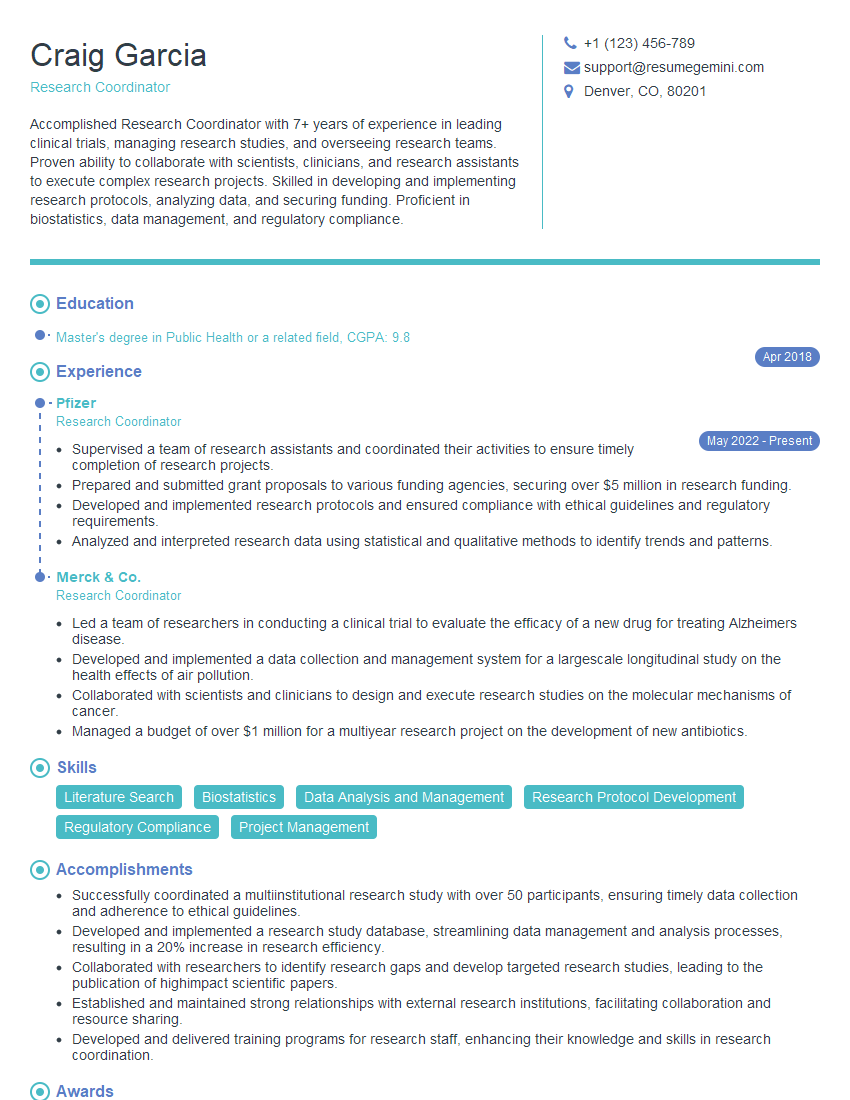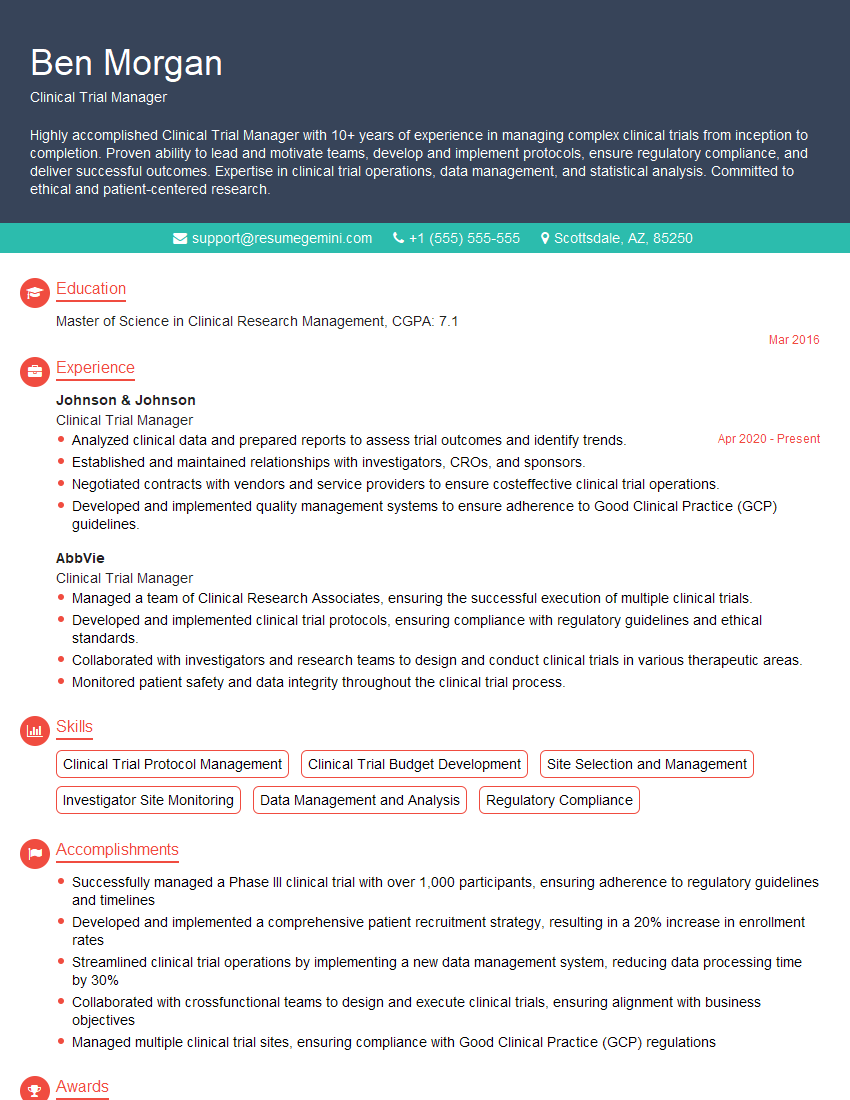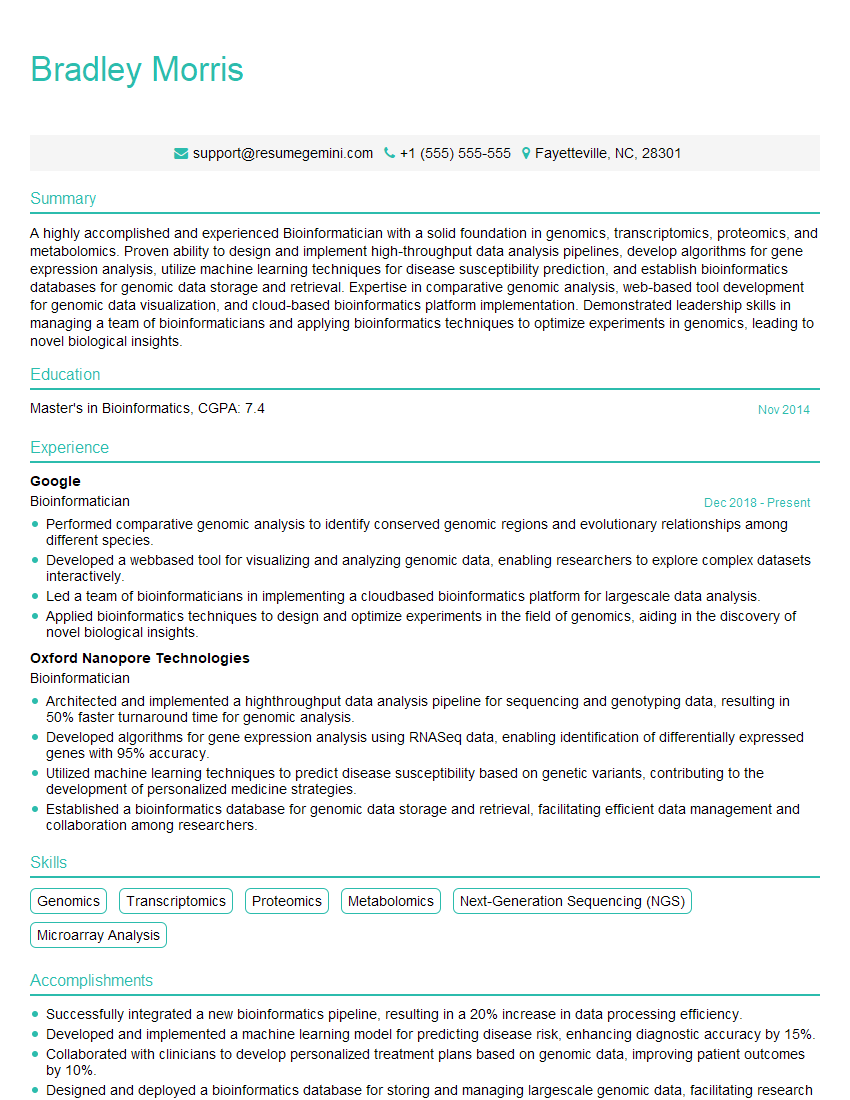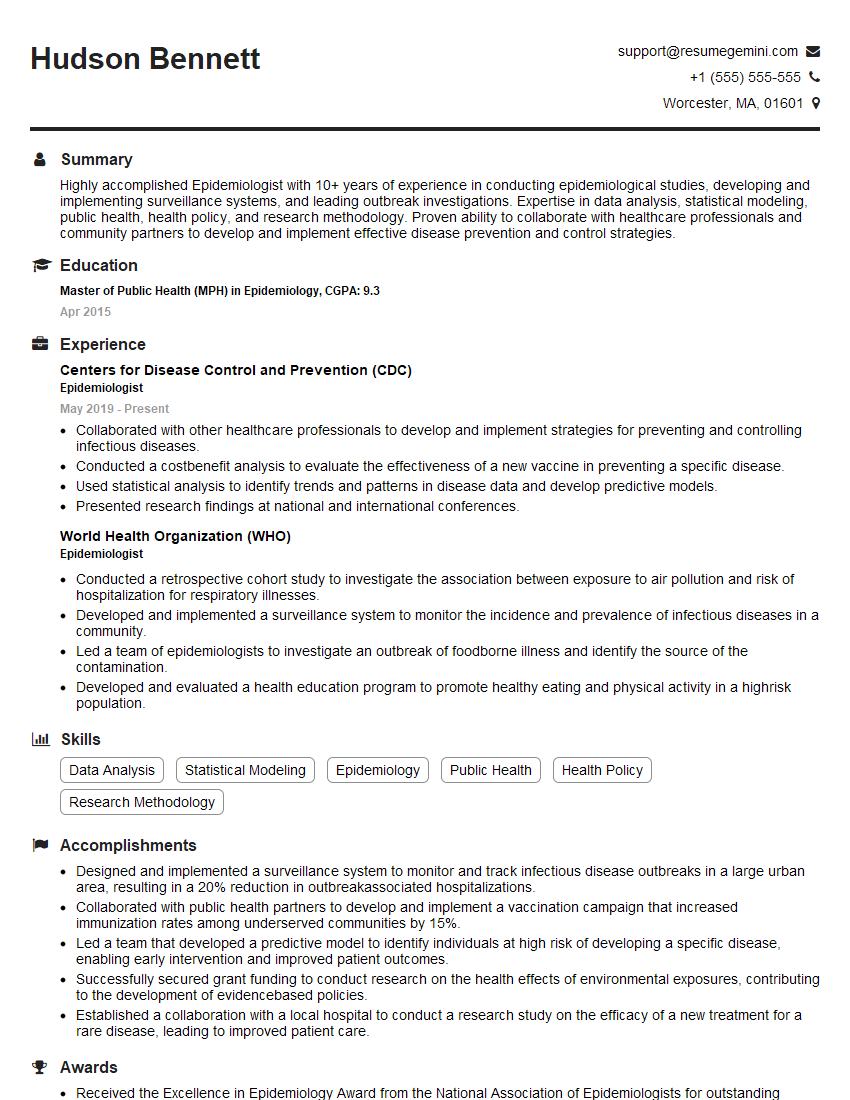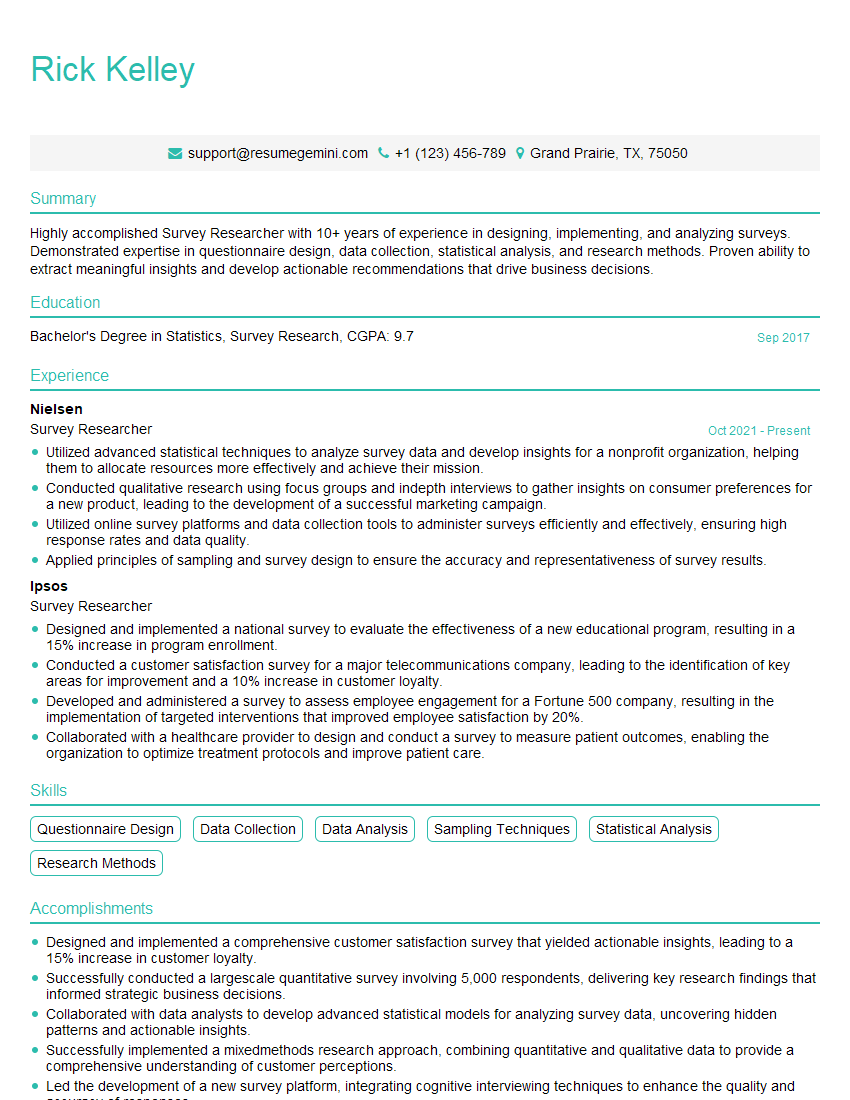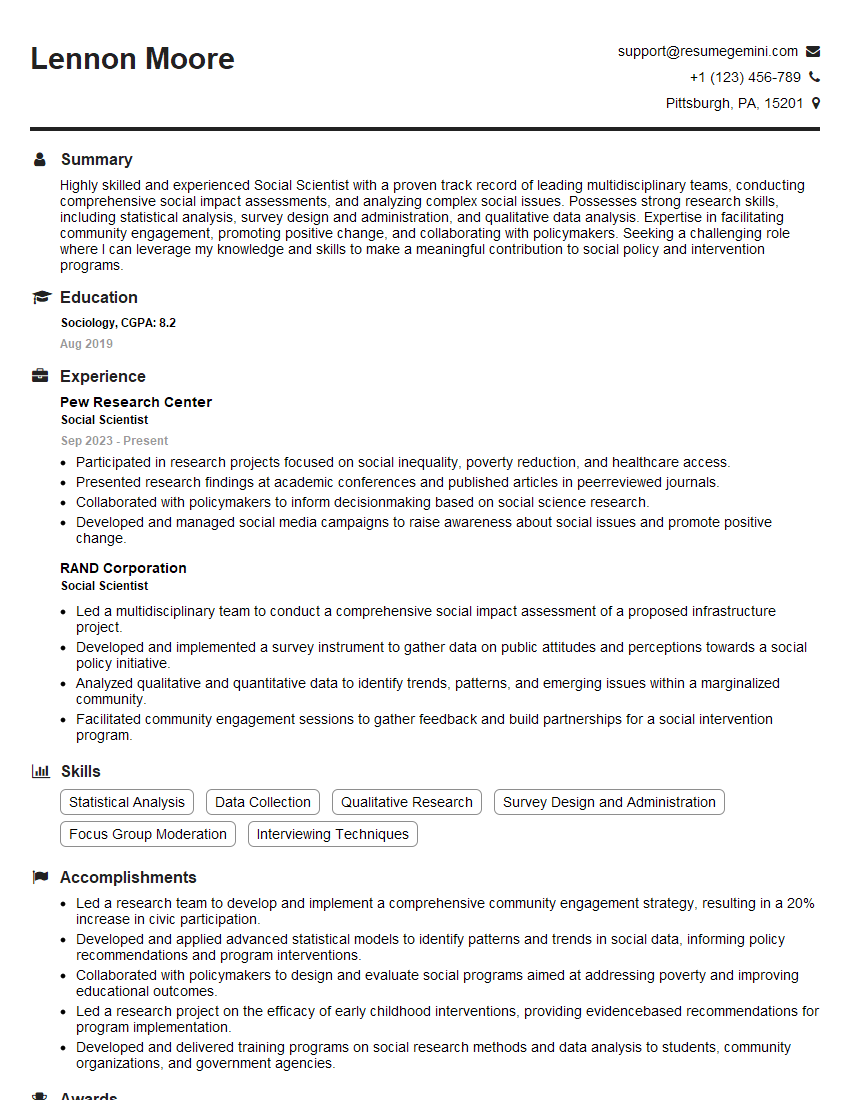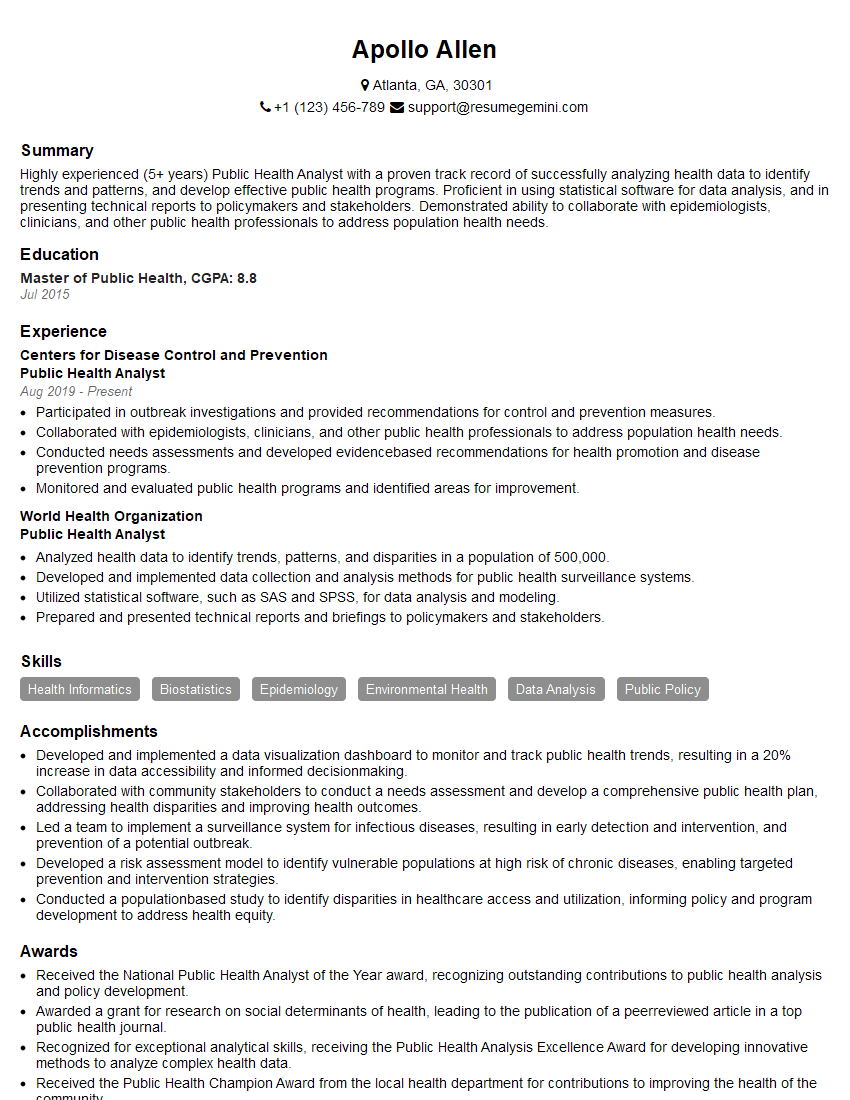Interviews are opportunities to demonstrate your expertise, and this guide is here to help you shine. Explore the essential Observational Studies interview questions that employers frequently ask, paired with strategies for crafting responses that set you apart from the competition.
Questions Asked in Observational Studies Interview
Q 1. Explain the difference between observational and experimental studies.
The core difference between observational and experimental studies lies in how the data is collected. In experimental studies, researchers actively manipulate an independent variable (e.g., a new drug) to observe its effect on a dependent variable (e.g., blood pressure). Participants are randomly assigned to different groups (treatment and control), allowing for causal inferences. Think of a clinical trial testing a new medication – the researchers control who receives the medication and who receives a placebo.
Observational studies, on the other hand, simply observe and measure variables without any intervention or manipulation. Researchers don’t assign treatments; they merely collect data on existing groups or individuals. For example, a study investigating the relationship between smoking and lung cancer wouldn’t force people to smoke; it would simply observe the smoking habits and health outcomes of a population.
The key takeaway is that experimental studies can establish cause-and-effect relationships, while observational studies can only identify associations. While observational studies cannot definitively prove causality due to the lack of control, they are often essential when ethical or practical constraints prevent experimental manipulation.
Q 2. What are the main types of observational studies?
Observational studies are broadly categorized into three main types:
- Cohort Studies: Follow a group of individuals (cohort) over time to observe the incidence of a particular outcome. For example, a cohort study might track a group of smokers and non-smokers to see who develops lung cancer.
- Case-Control Studies: Compare individuals with a particular outcome (cases) to those without the outcome (controls) to identify risk factors. For example, a case-control study might compare people with heart disease (cases) to people without heart disease (controls) to see if there are differences in their diets.
- Cross-Sectional Studies: Collect data on a population at a single point in time to examine the prevalence of a particular outcome or characteristic. For example, a cross-sectional study might survey a group of adults to determine the prevalence of diabetes in that population.
Q 3. Describe the strengths and limitations of cohort studies.
Strengths of Cohort Studies:
- Can directly measure incidence and risk of disease.
- Can establish temporal relationships (exposure precedes outcome).
- Can study multiple outcomes from a single exposure.
Limitations of Cohort Studies:
- Can be expensive and time-consuming (long follow-up periods).
- Prone to loss to follow-up, which can bias results.
- Difficult to study rare outcomes.
- Susceptible to confounding variables if not properly addressed.
Example: The Framingham Heart Study, a landmark cohort study, has followed generations of participants to identify risk factors for cardiovascular disease.
Q 4. Describe the strengths and limitations of case-control studies.
Strengths of Case-Control Studies:
- Relatively inexpensive and quick to conduct.
- Well-suited for studying rare outcomes.
- Can investigate multiple exposures for a single outcome.
Limitations of Case-Control Studies:
- Cannot directly measure incidence or risk.
- Difficult to establish temporal relationships (recall bias).
- Prone to selection bias and confounding.
- Often relies on retrospective data, which may be inaccurate.
Example: A study investigating the link between exposure to a specific chemical and a rare type of cancer might use a case-control design, comparing individuals with the cancer to a control group without the cancer.
Q 5. Describe the strengths and limitations of cross-sectional studies.
Strengths of Cross-Sectional Studies:
- Relatively inexpensive and quick to conduct.
- Provides prevalence data for a population at a specific time.
- Can study multiple exposures and outcomes simultaneously.
Limitations of Cross-Sectional Studies:
- Cannot establish temporal relationships (cannot determine cause and effect).
- Prone to selection bias.
- Only provides a snapshot in time; findings might not be generalizable to other time periods.
Example: A survey measuring the prevalence of obesity and physical activity levels in a particular community at a single point in time would be a cross-sectional study.
Q 6. What are confounding variables and how do they affect observational studies?
Confounding variables are extraneous factors that influence both the exposure and outcome of interest, potentially distorting the observed relationship between them. They are essentially hidden variables that muddle the true association. Imagine you’re studying the relationship between ice cream sales and drowning incidents. Both increase in the summer, creating an apparent link. However, the hot weather is a confounding variable; it affects both ice cream sales and drowning rates independently, creating a spurious correlation.
In observational studies, confounding variables can lead to biased estimates of the effect of an exposure on an outcome. If not accounted for, they can mask true associations or create false ones, leading to incorrect conclusions.
Q 7. How do you control for confounding variables in observational studies?
Controlling for confounding variables in observational studies is crucial for obtaining valid results. Several strategies exist:
- Study Design: Careful study design can minimize confounding. For example, restriction limits the study to participants with similar characteristics on potential confounders. Matching pairs individuals in the study groups based on confounders.
- Statistical Methods: Statistical techniques like stratification, regression analysis (e.g., logistic regression, Cox proportional hazards regression), and propensity score matching adjust for confounders after data collection. These methods statistically account for the influence of the confounding variable, providing a more accurate estimate of the exposure’s effect.
- Sensitivity Analysis: Explore how the results change when different assumptions or adjustments are made regarding potential confounders. This assessment helps gauge the robustness of the findings to confounding.
The choice of method depends on the specific study design, data available, and the nature of the confounding variables. Often a combination of strategies is employed.
Q 8. Explain the concept of selection bias.
Selection bias occurs when the way participants are selected for a study leads to a sample that is not representative of the population of interest. This means the conclusions drawn from the study may not be generalizable to the broader population. Imagine trying to understand the average height of adults in a city by only measuring the heights of people attending a basketball game – you’d likely overestimate the average height! This is because basketball players are a non-random, self-selected group, not representative of the entire adult population.
There are several types of selection bias, including:
- Sampling bias: Occurs when the sampling method itself favors certain individuals, such as only surveying people who own smartphones for a study about internet usage.
- Non-response bias: Happens when individuals selected for the study choose not to participate, and those who don’t participate differ systematically from those who do.
- Attrition bias: Arises when participants drop out of a study over time, and those who drop out differ systematically from those who remain.
To mitigate selection bias, researchers employ techniques like random sampling, stratified sampling, and careful consideration of the study population and recruitment methods.
Q 9. Explain the concept of information bias.
Information bias arises from systematic errors in the measurement or classification of variables. This means the data collected doesn’t accurately reflect the true values. Think of a study investigating the link between coffee consumption and heart disease where participants misremember how much coffee they drink. This inaccurate reporting introduces bias into the study’s findings.
Common types of information bias include:
- Recall bias: Occurs when participants have different abilities to recall past events, such as accurately remembering past exposure to a certain environmental factor.
- Interviewer bias: Arises when the interviewer’s knowledge or beliefs influence how they ask questions or interpret responses. For example, an interviewer might subtly lead a participant towards a specific answer.
- Measurement bias: Stems from flawed measurement tools or techniques. For example, using an inaccurate scale to weigh patients in a study assessing weight loss.
Minimizing information bias involves using standardized measurement protocols, blinding interviewers to the study hypotheses, and using objective and reliable data collection methods.
Q 10. How do you assess the validity and reliability of observational study findings?
Assessing the validity and reliability of observational study findings is crucial. Validity refers to whether the study measures what it intends to measure, while reliability refers to the consistency of the measurements.
We assess validity through several methods:
- Internal validity: Examines whether the study’s conclusions are accurate within the context of the study itself. We consider factors like the presence of confounding variables and biases.
- External validity: Determines how well the study’s findings can be generalized to other populations and settings. This hinges on the representativeness of the sample.
Reliability is assessed by:
- Repeatability: Can the study be replicated with similar results?
- Internal consistency: Do different parts of the study yield consistent findings?
Techniques like sensitivity analysis (assessing the impact of minor changes in the data or assumptions), assessing the strength of associations, and comparing results across multiple studies help enhance the assessment of both validity and reliability.
Q 11. What are the ethical considerations in conducting observational studies?
Ethical considerations are paramount in observational studies. Researchers must prioritize participant well-being and respect their autonomy.
Key ethical considerations include:
- Informed consent: Participants must be fully informed about the study’s purpose, procedures, risks, and benefits before agreeing to participate.
- Confidentiality and anonymity: Protecting the privacy of participants’ data is critical. Data should be anonymized whenever possible, and strict procedures must be in place to safeguard sensitive information.
- Data security: Robust measures should be in place to prevent unauthorized access to study data.
- Potential harm: Researchers need to identify and minimize potential harms to participants, including psychological distress or social stigma.
- Beneficence: Studies should aim to maximize benefits and minimize potential risks to participants and society.
- Justice: The benefits and burdens of participation should be fairly distributed.
Institutional review boards (IRBs) play a vital role in reviewing study protocols to ensure ethical standards are met.
Q 12. How do you interpret odds ratios and relative risks?
Odds ratios (OR) and relative risks (RR) are measures of association used in observational studies. They quantify the strength of the relationship between an exposure and an outcome.
Odds Ratio (OR): The OR is the ratio of the odds of an outcome in the exposed group to the odds of the outcome in the unexposed group. An OR of 1 indicates no association; an OR greater than 1 indicates a positive association (increased odds of the outcome in the exposed group); and an OR less than 1 indicates a negative association (decreased odds of the outcome in the exposed group).
Relative Risk (RR): The RR is the ratio of the risk of an outcome in the exposed group to the risk of the outcome in the unexposed group. An RR of 1 indicates no association; an RR greater than 1 indicates increased risk in the exposed group; and an RR less than 1 indicates decreased risk in the exposed group.
Example: Let’s say we’re studying the association between smoking and lung cancer. If the OR is 2.5, it means that smokers have 2.5 times the odds of developing lung cancer compared to non-smokers. If the RR is 2.5, it means smokers have 2.5 times the risk of developing lung cancer compared to non-smokers.
The key difference is that OR uses odds, while RR uses probabilities. The interpretation is similar, but RR is generally preferred when the outcome is relatively common.
Q 13. Explain the concept of causal inference in observational studies.
Causal inference in observational studies aims to determine whether an exposure truly causes an outcome, rather than merely being associated with it. This is challenging because observational studies lack the controlled environment of randomized controlled trials. We can’t definitively prove causation, but we can build a strong case using several approaches.
Key strategies for causal inference include:
- Developing a strong causal hypothesis: A clear and well-defined hypothesis is essential. This should be based on prior knowledge and biological plausibility.
- Controlling for confounding variables: These are factors that affect both the exposure and the outcome, potentially distorting the association between them. Techniques like stratification, matching, and regression analysis help control for confounders.
- Assessing temporality: The exposure must precede the outcome. Careful consideration of the study design is crucial to ensure this.
- Using causal diagrams: These help visualize potential causal pathways and identify confounders.
- Employing advanced statistical techniques: Techniques like propensity score matching, instrumental variables, and causal inference methods help to reduce bias and strengthen causal inferences.
It’s important to remember that even with rigorous analysis, observational studies can only provide evidence for causality, not definitive proof.
Q 14. How can you use regression analysis to analyze data from observational studies?
Regression analysis is a powerful tool for analyzing data from observational studies. It allows researchers to examine the relationship between an outcome variable and several predictor variables, while controlling for potential confounders.
Several regression methods are commonly used:
- Linear regression: Used when the outcome variable is continuous (e.g., blood pressure).
- Logistic regression: Used when the outcome variable is binary (e.g., presence or absence of a disease).
- Poisson regression: Used when the outcome variable represents count data (e.g., number of hospitalizations).
Example (Linear Regression): Let’s say we’re studying the effect of age and smoking on blood pressure. A linear regression model might look like this:
blood_pressure = β0 + β1*age + β2*smoking + εwhere:
blood_pressureis the outcome variable.ageandsmokingare predictor variables.β0is the intercept.β1andβ2are the regression coefficients, representing the effect of age and smoking on blood pressure, respectively.εis the error term.
The regression coefficients can be used to estimate the effect of age and smoking on blood pressure, while controlling for the other variable. Similar analyses can be performed using logistic or Poisson regression depending on the type of outcome variable.
Q 15. What are the limitations of using observational studies to establish causality?
Observational studies, unlike randomized controlled trials, don’t randomly assign participants to treatment groups. This inherent limitation makes establishing causality challenging because of confounding variables. Confounders are factors that influence both the exposure (treatment) and the outcome, creating a spurious association. For example, if we observe a correlation between coffee consumption and heart disease, it’s difficult to definitively say that coffee *causes* heart disease. It might be that smokers, who are more likely to drink coffee, also have a higher risk of heart disease. Smoking would then be a confounder.
Other limitations include:
- Selection bias: Participants might self-select into groups based on their characteristics, leading to skewed results.
- Information bias: Inaccurate or incomplete data collection can lead to biased estimates.
- Residual confounding: Even after adjusting for known confounders, some unmeasured or unmeasurable confounders may remain, affecting the results.
Therefore, while observational studies can generate valuable hypotheses and demonstrate associations, they rarely provide definitive proof of causality. Careful study design, rigorous statistical analysis, and acknowledging limitations are crucial when interpreting findings.
Career Expert Tips:
- Ace those interviews! Prepare effectively by reviewing the Top 50 Most Common Interview Questions on ResumeGemini.
- Navigate your job search with confidence! Explore a wide range of Career Tips on ResumeGemini. Learn about common challenges and recommendations to overcome them.
- Craft the perfect resume! Master the Art of Resume Writing with ResumeGemini’s guide. Showcase your unique qualifications and achievements effectively.
- Don’t miss out on holiday savings! Build your dream resume with ResumeGemini’s ATS optimized templates.
Q 16. What are propensity score matching and inverse probability weighting?
Propensity score matching and inverse probability weighting are statistical techniques used to reduce confounding bias in observational studies. They aim to create a more balanced comparison between the treatment and control groups by accounting for the observed confounders.
Propensity score matching calculates the probability of receiving the treatment (the propensity score) for each individual based on their observed characteristics. It then matches individuals in the treatment group with similar propensity scores in the control group, creating pairs or groups with similar confounding profiles. This helps to ensure that the comparison between groups is fair, mitigating the influence of confounders.
Inverse probability weighting assigns weights to each individual based on their propensity score. Individuals with a lower probability of receiving the treatment (e.g., those in the control group who are similar to the treated group) receive higher weights, essentially increasing their representation in the analysis. This method effectively balances the distribution of confounders between the treatment and control groups.
Imagine comparing the effectiveness of a new drug versus a placebo. If patients with severe illness are more likely to receive the new drug, propensity score methods help account for this imbalance, offering a more accurate assessment of the drug’s efficacy.
Q 17. How do you address missing data in observational studies?
Missing data is a pervasive issue in observational studies. Ignoring it can lead to biased and inaccurate results. Several methods exist to address this:
- Complete Case Analysis: The simplest method, but it excludes all participants with any missing data. This leads to loss of information and potential bias if missingness is related to the outcome or exposure.
- Imputation: This involves filling in missing values using various techniques. Mean imputation replaces missing values with the average of the observed values. Multiple imputation creates multiple plausible datasets, each with different imputed values, allowing for uncertainty estimation. More sophisticated methods like multiple imputation by chained equations (MICE) handle different data types better and account for correlations between variables.
- Inverse Probability Weighting (IPW) for Missing Data: Similar to IPW for confounding, this method assigns weights to individuals based on their probability of having complete data. This can adjust for biases caused by missing data if the missingness is related to observed covariates.
- Maximum Likelihood Estimation: A statistical approach that estimates parameters by maximizing the likelihood of the observed data, taking into account the missingness mechanism.
The choice of method depends on the pattern and mechanism of missing data (Missing Completely at Random (MCAR), Missing at Random (MAR), Missing Not at Random (MNAR)). It’s crucial to assess the sensitivity of results to different missing data handling methods.
Q 18. Discuss different methods for handling time-varying confounders.
Time-varying confounders are variables that change over time and influence both the exposure and the outcome. Ignoring them can lead to biased estimates of the treatment effect. Several strategies exist to handle them:
- Stratification: Analyze the data separately for different levels of the time-varying confounder. For example, if age is a time-varying confounder, analyze the data separately for different age groups.
- Matching: Similar to propensity score matching, but matching is done on the time-varying confounder values across different time points.
- Conditional regression models: These models adjust for time-varying confounders by including them as covariates in the regression model. This could include using time-dependent covariates in Cox proportional hazards models for survival data or generalized estimating equations (GEE) for longitudinal data.
- Instrumental Variables (IV): If a variable influences the exposure but not directly the outcome (except through the exposure), it can be used as an instrument to disentangle the confounding effect.
- G-computation algorithm: This algorithm simulates counterfactual outcomes by adjusting for the time-varying confounders at each time point. It’s a powerful method that provides more flexible handling of complex time-dependent relationships.
The best approach depends on the specific research question and the nature of the time-varying confounders. Often, a combination of these techniques is used to mitigate bias.
Q 19. Explain the difference between a prospective and retrospective cohort study.
Both prospective and retrospective cohort studies follow a group of individuals (the cohort) over time to investigate the association between an exposure and an outcome. The key difference lies in when the data is collected:
Prospective cohort studies identify a cohort at the beginning of the study and follow them forward in time, collecting data on exposure and outcome as they occur. This design allows for more accurate measurement of exposures and reduces recall bias (errors in remembering past events). However, they are expensive, time-consuming, and may be subject to loss to follow-up.
Retrospective cohort studies use existing data collected in the past to identify a cohort and their exposure status. Outcomes are assessed based on existing records. This approach is less expensive and time-consuming, allowing for faster results. However, it relies on the quality of existing data and may be prone to selection bias and information bias. Recall bias is also a concern.
For example, a prospective study on the effects of smoking on lung cancer would recruit non-smokers and smokers and follow them for years, recording cancer incidence. A retrospective study would use existing medical records to examine the smoking habits of patients who developed lung cancer compared to a control group.
Q 20. How do you determine the appropriate sample size for an observational study?
Determining the appropriate sample size for an observational study depends on several factors:
- The effect size you expect to observe: Larger effects require smaller sample sizes than smaller effects.
- The desired level of statistical power: Higher power (ability to detect a true effect) requires larger sample sizes.
- The significance level (alpha): Usually set at 0.05.
- The prevalence of the exposure and outcome in the population: Rare exposures or outcomes require larger sample sizes.
- The number of covariates you plan to adjust for: More covariates generally require larger sample sizes.
Sample size calculations often involve statistical software or online calculators that require inputting these parameters. Power analysis is crucial; it helps determine the sample size needed to ensure the study has a reasonable chance of detecting an effect of a given size, assuming it exists. Under-powered studies may fail to detect real effects, leading to inconclusive results.
Q 21. What are some common statistical software packages used in observational studies?
Many statistical software packages are widely used for analyzing data from observational studies. Popular choices include:
- R: A powerful and flexible open-source software with extensive packages for statistical modeling, including causal inference techniques. Packages like
MatchIt,twang(for propensity score methods), andsurvival(for survival analysis) are widely used. - SAS: A comprehensive commercial software package offering a wide range of statistical procedures and capabilities for managing and analyzing large datasets.
- Stata: Another popular commercial statistical package with strong support for causal inference and various regression modeling techniques.
- SPSS: User-friendly commercial software, particularly suitable for researchers less experienced in statistical programming.
The choice of software often depends on the researcher’s familiarity, available resources, and the specific analysis needs. R’s flexibility and open-source nature make it a popular choice among researchers involved in developing new statistical methods for observational studies.
Q 22. Explain the importance of defining a clear research question before starting an observational study.
A well-defined research question is the cornerstone of any successful observational study. It acts as a compass, guiding the entire research process from study design to data analysis and interpretation. Without a clear research question, the study risks becoming unfocused, leading to ambiguous results and wasted resources.
A good research question is:
- Specific: It clearly identifies the population, exposure, and outcome of interest. For example, instead of asking “Does diet affect heart health?”, a better question would be “Does a Mediterranean diet reduce the risk of cardiovascular disease in postmenopausal women aged 50-65?”
- Measurable: The variables involved must be objectively defined and measurable. How will you define and measure “Mediterranean diet” and “cardiovascular disease”?
- Achievable: The study should be feasible within the available resources (time, budget, data accessibility).
- Relevant: The question should address a significant gap in knowledge and have potential to inform practice or policy.
- Time-bound: The study should have a defined timeframe.
For example, failing to define a clear research question could lead to collecting irrelevant data, making it impossible to answer any meaningful questions about the phenomenon under study. Conversely, a precise research question ensures that data collection and analysis are efficient and targeted.
Q 23. How do you evaluate the generalizability of findings from an observational study?
Generalizability, also known as external validity, refers to the extent to which the findings of an observational study can be applied to a broader population beyond the specific sample studied. Evaluating generalizability requires careful consideration of the study’s sampling methods, participant characteristics, and the context in which the study was conducted.
Here’s how to evaluate generalizability:
- Sampling Methods: Was the sample representative of the target population? Were appropriate sampling techniques used (e.g., random sampling, stratified sampling) to minimize bias? A biased sample limits generalizability.
- Participant Characteristics: How well do the characteristics of the study participants (age, sex, ethnicity, socioeconomic status, etc.) reflect the target population? Significant differences might limit generalizability.
- Study Setting: Was the study conducted in a setting that is typical of the target population’s environment? Findings from a highly specialized clinical setting may not generalize to the broader population.
- Replication Studies: Conducting similar studies in different settings or with different populations can strengthen generalizability. Consistency across multiple studies increases confidence in the findings’ applicability.
- Statistical Adjustment: Statistical techniques can sometimes mitigate the impact of confounding variables and improve the generalizability of the results.
For example, a study on the effectiveness of a new drug conducted solely on a group of young, healthy male volunteers may not be generalizable to older women with pre-existing health conditions.
Q 24. Describe a time you had to overcome challenges in analyzing data from an observational study.
In a study examining the association between air pollution and respiratory health in children, I encountered missing data. A significant number of participants had incomplete records for either air pollution exposure measurements (due to malfunctioning sensors) or respiratory health assessments (due to missed appointments). Simply excluding these participants would have introduced selection bias, threatening the validity of my conclusions.
To overcome this challenge, I employed multiple imputation techniques. This involved using statistical methods to create multiple plausible datasets, each filling in the missing values differently based on patterns observed in the complete data. I then analyzed each imputed dataset and combined the results to obtain more robust and less biased estimates of the association between air pollution and respiratory health. This approach allowed me to utilize all available data while acknowledging and mitigating the uncertainty introduced by missing values. It was crucial to clearly document the imputation strategy in the study report for transparency and reproducibility.
Q 25. What are some common threats to the internal validity of an observational study?
Internal validity refers to the extent to which a study accurately measures what it intends to measure, ensuring that observed effects are truly due to the exposure of interest and not other factors. Several threats can compromise internal validity in observational studies:
- Confounding: A confounder is a third variable that is associated with both the exposure and the outcome, potentially distorting the observed relationship. For example, in a study examining the association between coffee consumption and heart disease, age could be a confounder, as older individuals might drink more coffee and also have a higher risk of heart disease.
- Selection Bias: This occurs when the selection of participants into the study groups is not random and is related to the outcome. For instance, if individuals with severe disease are more likely to be enrolled in a study, the results may overestimate the severity of the disease.
- Information Bias: This involves errors in measuring the exposure or outcome. Recall bias, for instance, occurs when participants’ memory of past events is inaccurate.
- Residual Confounding: Even after adjusting for known confounders in the analysis, residual confounding might remain if some confounders were not measured or poorly measured.
Addressing these threats requires careful study design, such as using appropriate statistical methods to adjust for confounders and employing rigorous data collection techniques to minimize bias.
Q 26. What are some common threats to the external validity of an observational study?
External validity, or generalizability, is threatened when the findings of an observational study cannot be extended to other populations, settings, or times. Here are some common threats:
- Sample Selection Bias: If the study sample is not representative of the target population, the results may not generalize to the broader group.
- Specific Study Context: The findings may only be applicable to the specific setting (e.g., a particular hospital or geographical region) in which the study was conducted.
- Temporal Changes: Findings from a study conducted several years ago might not be relevant in the present day due to changes in lifestyles, treatments, or environmental factors.
- Limited Scope of Exposure: A study that only examines a narrow range of exposure levels may limit the generalizability of the findings to broader exposure ranges.
To improve external validity, researchers should strive to use diverse and representative samples, conduct the study in multiple settings if possible, and consider the temporal limitations of their findings. Clearly articulating the limitations of generalizability in the study report is also crucial.
Q 27. How do you communicate the findings of an observational study to a non-technical audience?
Communicating complex observational study findings to a non-technical audience requires careful consideration of the audience’s knowledge and interests. The key is to translate technical jargon into plain language, using visuals to enhance understanding.
Here’s a step-by-step approach:
- Start with the “So What?”: Begin by highlighting the main finding and its significance in simple terms. What is the practical implication of the research?
- Use Analogies and Visual Aids: Relate the findings to everyday experiences or use charts, graphs, and infographics to illustrate key results.
- Avoid Jargon: Replace technical terms with clear, concise language. If you must use a technical term, define it in simple terms.
- Focus on the Story: Present the findings as a narrative, emphasizing the context and the implications of the research.
- Emphasize Uncertainty: Acknowledge the limitations of the study, especially regarding causality. Observational studies do not prove cause-and-effect relationships, but they can suggest associations.
- Address Potential Concerns: Anticipate questions or concerns the audience might have, and address them directly.
For example, instead of saying “Our analysis revealed a statistically significant positive association between exposure to air pollutants and respiratory morbidity,” you could say, “We found that children living in areas with more air pollution were more likely to experience respiratory problems like asthma and bronchitis.”
Q 28. Explain the role of observational studies in generating hypotheses for future research.
Observational studies play a critical role in generating hypotheses for future research. Because they examine existing data without manipulating variables, they can uncover patterns and associations that might not be apparent otherwise. These associations can then guide the design of experimental studies to test specific causal relationships.
Here’s how observational studies contribute to hypothesis generation:
- Identifying Potential Risk Factors: Observational studies can pinpoint potential risk factors for diseases or other outcomes, leading to hypotheses about their causal roles. For example, an observational study might show an association between smoking and lung cancer, prompting a hypothesis that smoking causes lung cancer.
- Exploring Potential Mechanisms: Observational studies can help researchers explore potential mechanisms underlying observed associations, providing insights for experimental studies. For instance, an observational study might reveal an association between a particular gene variant and a specific disease, which could lead to further research into the gene’s role in disease pathogenesis.
- Investigating Interactions: They can identify potential interactions between different factors influencing an outcome. This can generate hypotheses about how these factors might interact causally.
- Developing New Research Questions: By identifying unexpected associations or gaps in knowledge, observational studies can stimulate the development of entirely new research questions and avenues of investigation.
It’s important to remember that associations observed in observational studies do not automatically imply causation. Experimental studies are generally needed to confirm causal relationships.
Key Topics to Learn for Observational Studies Interview
- Study Design: Understand the different types of observational studies (cohort, case-control, cross-sectional) and their strengths and weaknesses. Be prepared to discuss the implications of various design choices on causality and bias.
- Bias and Confounding: Master the identification and mitigation of various biases (selection bias, information bias, confounding) in observational studies. Discuss strategies for controlling for confounders, such as stratification, matching, and regression adjustment.
- Causal Inference: Develop a strong understanding of causal inference frameworks, including directed acyclic graphs (DAGs) and potential outcomes. Be ready to discuss how to infer causality from observational data, acknowledging inherent limitations.
- Data Analysis Techniques: Familiarize yourself with statistical methods used in observational studies, including regression analysis (linear, logistic, Cox proportional hazards), propensity score matching, and instrumental variables.
- Interpreting Results: Practice interpreting results from observational studies, focusing on the limitations and potential biases. Be prepared to discuss the implications of findings and their generalizability.
- Ethical Considerations: Understand the ethical implications of conducting observational studies, particularly regarding data privacy and informed consent.
- Practical Applications: Be prepared to discuss real-world applications of observational studies in various fields (e.g., epidemiology, public health, economics). Consider examples from your own experience or research.
- Limitations of Observational Studies: Critically evaluate the inherent limitations of observational studies compared to randomized controlled trials. Understand when observational studies are appropriate and when they are not.
Next Steps
Mastering observational studies is crucial for career advancement in many data-driven fields. A strong understanding of these methods demonstrates valuable analytical skills and the ability to draw meaningful insights from complex data. To significantly boost your job prospects, crafting an ATS-friendly resume is essential. This ensures your application gets noticed by recruiters and hiring managers. We strongly recommend leveraging ResumeGemini to create a compelling and effective resume tailored to your specific skills and experience in observational studies. ResumeGemini offers examples of resumes specifically designed for observational studies professionals to help you create a winning application.
Explore more articles
Users Rating of Our Blogs
Share Your Experience
We value your feedback! Please rate our content and share your thoughts (optional).
What Readers Say About Our Blog
Hello,
We found issues with your domain’s email setup that may be sending your messages to spam or blocking them completely. InboxShield Mini shows you how to fix it in minutes — no tech skills required.
Scan your domain now for details: https://inboxshield-mini.com/
— Adam @ InboxShield Mini
Reply STOP to unsubscribe
Hi, are you owner of interviewgemini.com? What if I told you I could help you find extra time in your schedule, reconnect with leads you didn’t even realize you missed, and bring in more “I want to work with you” conversations, without increasing your ad spend or hiring a full-time employee?
All with a flexible, budget-friendly service that could easily pay for itself. Sounds good?
Would it be nice to jump on a quick 10-minute call so I can show you exactly how we make this work?
Best,
Hapei
Marketing Director
Hey, I know you’re the owner of interviewgemini.com. I’ll be quick.
Fundraising for your business is tough and time-consuming. We make it easier by guaranteeing two private investor meetings each month, for six months. No demos, no pitch events – just direct introductions to active investors matched to your startup.
If youR17;re raising, this could help you build real momentum. Want me to send more info?
Hi, I represent an SEO company that specialises in getting you AI citations and higher rankings on Google. I’d like to offer you a 100% free SEO audit for your website. Would you be interested?
Hi, I represent an SEO company that specialises in getting you AI citations and higher rankings on Google. I’d like to offer you a 100% free SEO audit for your website. Would you be interested?
good
